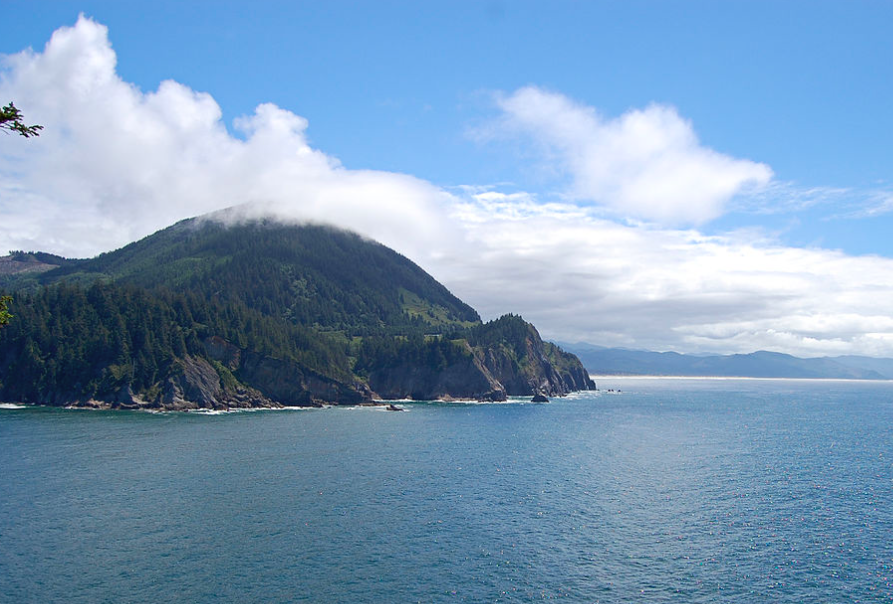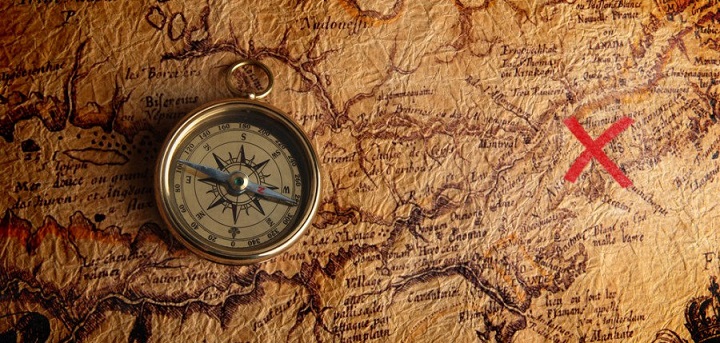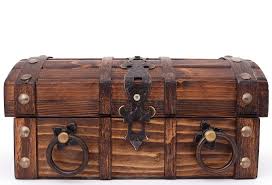Oregon Coast Treasure At Neahkahnie Mountain

Photo courtesy Wikipedia Commons. User: Fcb981
For many treasure hunters, getting genuine first-hand information that can help to find hidden gems has been elusive for hundreds of years. The northern Oregon Coast has its fair share of legends but one particular story has survived generations of Native Americans living around Nehalem Bay. While insightful questions regarding the actual location of the hidden treasure persist, the hunt and determination to find it still lives on and has even inspired works of art including the 2006 movie The Tillamook Treasure.
The Northern Oregon Coast
The picturesque Oregon Coast combines the natural beauty of lush forests, pristine beaches and the stunning backdrop of rolling mountains. Behind all these is the story of some lost fortune, tucked away at some depth in the mountains, captivating the imaginations of generations of local folks, treasure seekers and adventurers from all walks of life.
This enigmatic tale of hidden treasure is not only steeped in mystery and adventure, but set in the majestic rugged cliffs of Neahkahnie Mountain. Overlooking U.S. Route 101, the mountain is located north of Manzanita in Oswald West State Park, Tillamook County. The scenic hillsides provide sweeping views of the Oregon Coast including Neahkahnie Beach, Nehalem Bay and the nearby town of Manzanita.
As part of the Northern Oregon Coast Range, Neahkahnie Mountain’s western face has precipitous cliffs that hang above the restless waves of the Pacific Ocean while its steep flanks are no less dangerous. The upper slopes of the mountain are covered by a dense forest that towers above meadows and native shrubs, completing the perfect location to hide a treasure trove.

The Spanish Connection
During the 1600s, Spanish galleons (sailing ships used for trade) crossed the Pacific at regular intervals between Mexico and colonies in the Philippines. These ships transported Spanish goods to the colonies and brought back gold, silver, pearls, spices and other exotic goods to the Spanish mainland. The ships that sailed from Manila to Acapulco were known as the Manila galleon. These ships would normally make landfall on the southern California coast but some of them found themselves on the Oregon coast.
Several treasure ships of the Manila galleon were lost at sea during that period. Spanish records indicate that at least 33 ships did not make it to their destination. Evidence of these shipwrecks has emerged over time in the form of chunks of beeswax along the beach on the slopes of Neahkahnie Mountain – this evidence is most likely from the Beeswax wreck that involved the Santo Cristo de Burgos, a Spanish galleon ferrying valuable wax that left Manila in 1693.
Also Read: One of the Largest Shipwreck Recoveries Ever! – The Ship of Gold
Lost Treasure At Neahkahnie Mountain
According to legend, Neahkahnie Mountain’s panoramic views are a veneer that is hiding buried treasures, stashed for hundreds of years and waiting to be discovered by today’s treasure hunters. Oral traditions have passed on this enduring story with such consistency, cementing Neahkahnie’s reputation as Northern Oregon’s treasure-seeking hotspot.
It all began in the 1600s when the Spanish galleons were traversing the Pacific Ocean in their trading business while evading capture by pirates and other foreign privateers. One such ship, laden with riches and possibly stricken in a storm or being part of a pirate gang, reached the Oregon coast. The ship anchored or ran aground offshore near Neahkahnie Mountain. The occupants used a boat to row through to the shore and climbed up Neahkahnie Mountain. The men carried a heavy chest thought to contain gold and other precious items to the top of the headland as curious natives watched.
The men dug a deep hole on the side of the mountain and buried the chest. However, they grew concerned that the natives might steal the treasure trove. One of the men drew out a sword and killed a dark-skinned fellow – most likely an African slave – and buried the dead man on top of the chest. This was apparently done with the knowledge that the natives’ culture forbade disturbing a man’s grave.
Satisfied that the natives wouldn’t dare to dig up a grave and therefore their treasure trove was safe, the men sailed away hoping to come back at a later date and retrieve their precious cargo. Despite some twists that have emerged to describe this final part of the tale (some version describes a bizarre incident where the captain shot dead the crew members who wouldn’t fit in the ship’s longboat before sailing off into the open sea), what is certain is that the men never came back for their cache, making Neahkahnie Mountain and nearby beaches some of the leading treasure-hunting sites in the state.

The “Mountain Of A Thousand Holes”
During the late nineteenth and well into the twentieth centuries, Neahkahnie Mountain experienced intensive treasure hunting that ravaged the mountainsides. The arrival of British expeditions in the 1800s brought visitors as well as European settlers who fuelled the hunt for the hidden treasures as tales from popular lore spread among the new arrivals. By the late twentieth century, the activities on the mountain and surrounding areas had reached their peak.
Several treasure hunting episodes stood out for the indelible mark they left on Neahkahnie mountain:
Aware of the legend, a fur trapper named Thomas McKay regularly dug the mountainsides, searching every nook and cranny. One day he quit his job and settled at French Prairie by the Willamette River. He left behind a rumor that he may have found the treasure when he suddenly became quite generous with cash. In 1865, an early settler and surveyor, Hiram Smith, began digging for treasure on the mountain. He eventually passed on his extensive knowledge to his son, Patrick Smith. For more than forty years, Patrick carried on his father’s fascination, searching multiple sites on the mountain. In the 1870s, he found some stones engraved with markings and arrows which were thought to be treasure maps indicating where the treasure was buried. In 1931, Charles Wood and his son Lynn Wood dug a large hole on the mountain in search of the hidden treasure. Without any formidable supports, the hole caved in, killing both men. In the 1940s, Charlie Pike sunk a shaft that was forty feet deep and four feet wide by deploying diamond drills and a bulldozer. In 1958, other treasure seekers came in from Seattle and dug one of the deepest pits on the mountain at 125 feet deep. Ed Fire, also known as Tony Mareno, was the first treasure hunter to work under Oregon’s new Treasure Trove law in 1967. He used heavy machinery including bulldozers to excavate the beach, drawing more people to the hunt. In 1990, Samuel Logan drowned after he was thrown out to sea by a wave while treasure-hunting in a cave on Neahkahnie Mountain.
Despite all these efforts, no treasure has been recovered from the mountain. Treasure tales that have fascinated visitors led to the use of modern equipment to dig deep pits and trenches across the mountain. With diggings everywhere, the headland became known as the “mountain of a thousand holes.”
Also Read: Where the Gold Stays Buried: 8 American Locations with NO Gold Mining
Modern-Day Neahkahnie Mountain
The hunt for the hidden treasure on Neahkahnie Mountain has taken twists and turns over the centuries. Use of crude maps and engraved stones has so far failed to pinpoint the true location of the treasure. Modern equipment and countless holes dug across the mountain have been fruitless but the spirit of exploration has endured.
Tales from local tribes have provided tantalizing hints and added mystery, inspiring a whole generation of treasure hunters seeking hidden fortunes. These tales, embedded in local folklore, have come with countless variations that some hunters have suggested were deliberately convoluted to mislead them.
The destruction witnessed on Neahkahnie Mountain was unprecedented with indiscriminate diggings that left abandoned trenches and holes in their wake. Today, digging for treasure is prohibited on some parts of the mountain and beach that are under the Oregon Parks and Recreation Department.
There are few things in treasure hunting that are both true and practical but there is a 100% chance that the tale of Neahkahnie Mountain is true. Every treasure hunter knows the captivating feeling of a pipe dream coming to fruition, and for serious folks who will finally say “I’m glad I kept trying,” the allure of a hidden treasure on Neahkahnie Mountain will continue beckoning.
Next: Ruggles Brothers Treasure – Stolen Gold in Redding, California







